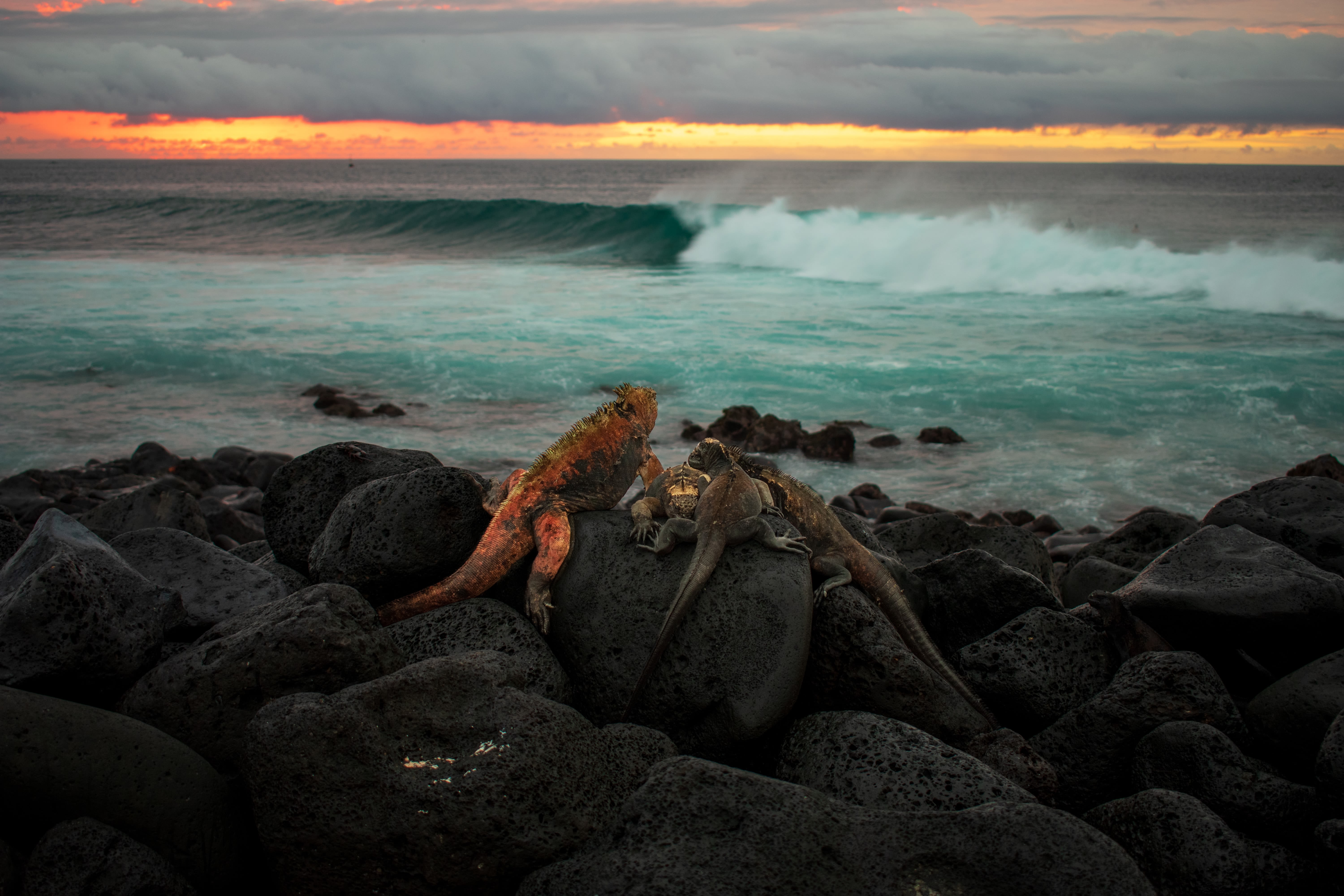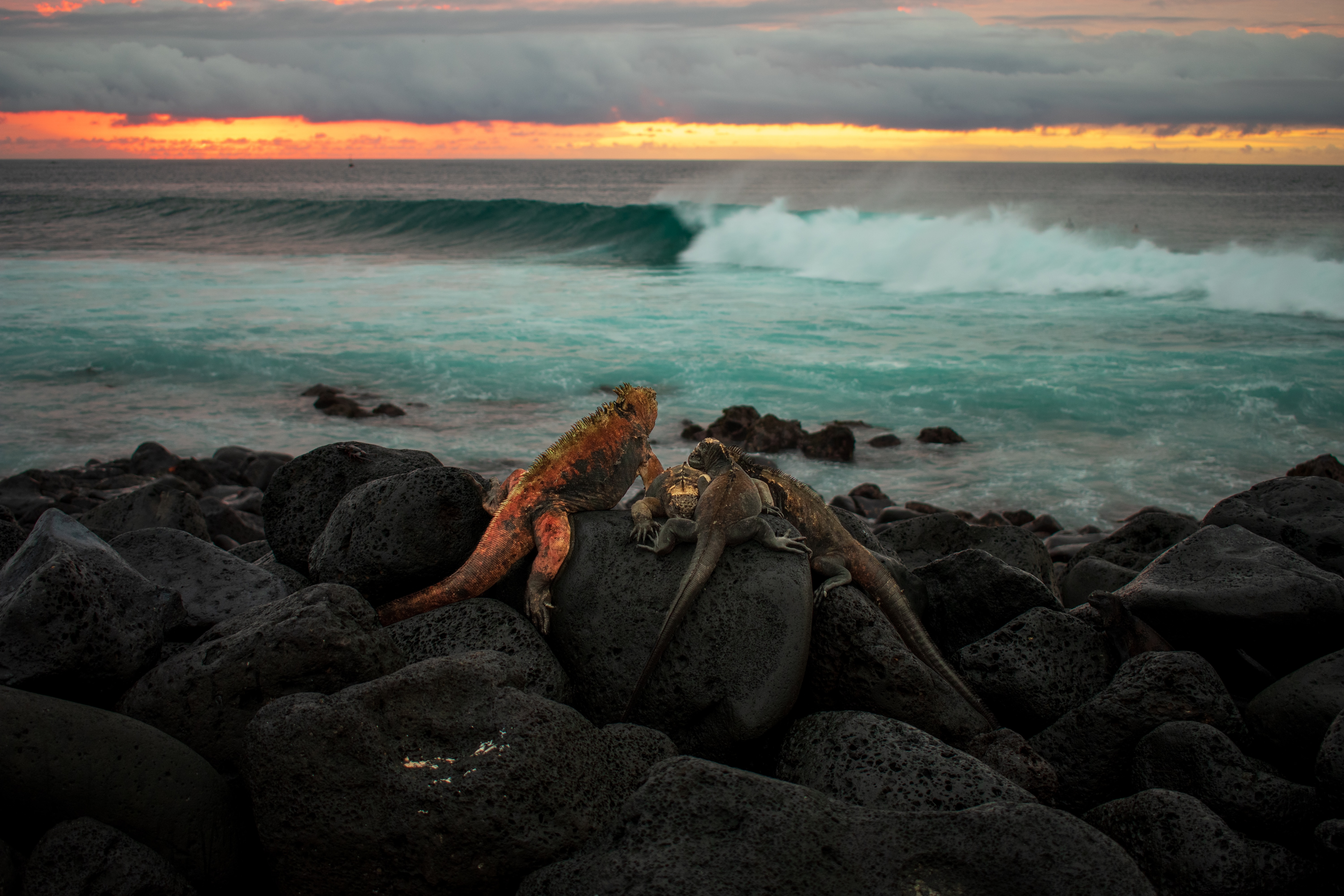A dream for wildlife lovers, the Galapagos Islands are best known for their unique animals, many of which can’t be seen anywhere else on the planet. Located 600 miles off mainland Ecuador right on the equator, the isolated archipelago is truly a one-of-a-kind destination as a microcosm of evolution. While many visit on expedition-type cruises, these trips tend to be very costly. The good news is that you can easily visit on your own for a more budget-friendly adventure with the help of this guide to the Galapagos Islands.
While there is no one best time to visit the Galapagos archipelago, which can be explored year-round, there are many reasons to come in the fall, which is primarily part of the cool, dry season that stretches from June through November. This is the breeding season for many animals here, including many sea birds, sea lions, and marine iguanas. As the plankton blooms during this period, attracting whale sharks, you’ll have the chance to swim alongside one of these massive yet docile creatures too.
What to Know About Exploring the Galapagos on Your Own
There are no direct flights to the Galapagos Islands outside of Ecuador as 97 percent of the archipelago is protected as a national park, and there are strict regulations all airlines must adhere to. To get to the Galapagos Islands, you’ll need to fly to either Quito or Guayaquil. From either destination, there are direct flights to the Galapagos, including Seymour Airport on Baltra Island and San Cristobal Airport on San Cristobal Island.
When visiting many destinations, you can easily pack light and buy what you might need after arrival, but as the Galapagos Islands are so remote, there are limited shopping opportunities. Something you might not think about is a water bottle. There is a ban on single-use plastics in the Galapagos and the tap water isn’t safe to drink. Bringing a reusable water bottle is really a must. The LARQ Bottle PureVis™ is highly recommended, using UV light to kill bacteria, eliminating up to 99.9999% of bio-contaminants from both the water and bottle.
Something else to consider is that there are few ATMs in the Galapagos Islands. They are available in Santa Cruz and San Cristobal islands, but they occasionally run out of cash. The U.S. dollar is the official currency of Ecuador, so it’s easy for Americans to bring. Smaller denominations are best, including $1, $5, $10, and $20 bills.
The Best Islands to Stay On
You’ll have a choice of four inhabited Galapagos Islands when it comes to accommodation: Isabela, San Cristobal, Floreana, and Santa Cruz Island. If you have the time, it’s worth staying on all of them as each one offers magnificent landscapes and lots of interesting wildlife. If you don’t have that luxury, you’ll want to know what makes them unique to make the best pick according to your interests.
Isabela Island
Covering 1,771 square miles, Isabela is the largest island in the Galapagos. Puerto Villamil is the main town, a small port village where the vast majority of the population lives, home to most of the hotels and other accommodations. The island is relatively undeveloped, ideal for those seeking a serene oasis and a laidback pace of life along with a wealth of wildlife sightings. It’s home to some 6,000 Galapagos giant tortoises, more than all the other islands combined. South American fur seals, flamingos, and iguanas are all commonly spotted, and this is the best island for penguins.
There are only limited amenities in Isabela but accommodation options have improved in recent years, with everything from basic budget hotels to newer properties with pools and top-notch restaurants.
Santa Cruz Island

Santa Cruz has the most tourist amenities, which is why it’s one of the most popular islands to stay on. When it comes to accommodation, you’ll find everything from vacation rental properties to luxury hotels that offer expeditions. Many of the hotels have outdoor pools. Some of the best are found in the capital of Puerto Ayora, including the world-renowned Finch Bay Hotel. This is also where you’ll find some of the best restaurants in the archipelago, along with grocery stores and ATMs. Many tours depart from Santa Cruz as well, making it an ideal choice for those who will be visiting the Galapagos for just a short time.
In terms of wildlife, Santa Cruz is home to abundant marine life, including sea turtles, rays, and sharks. There are healthy populations of both marine iguanas and land iguanas here, along with the Galapagos tortoise. Plus, eight different finch species and large colonies of breeding blue-footed boobies can be found here. If you want to see more, North Seymour is an easy day trip from Santa Cruz, and one of the top seabird breeding grounds in the Galapagos, with blue-footed boobies sightings frequent. Magnificent frigatebirds are often seen too. Another reason to spend time in Santa Cruz itself is Tortuga Bay, a long stretch of pristine sands edging turquoise water where black sea turtles nest.
San Cristobal Island

The easternmost island in the Galapagos, San Cristobal is far less busy compared to Santa Cruz, but it has plenty of conveniences, including dining venues and hotels. The capital of the Galapagos is found here on the southwestern coast, Puerto Baquerizo Moreno. Boat tours depart from here for excursions to Kicker Rock, an iconic wildlife haven where sea lions are strewn across postcard-perfect stretches of sand. It’s a popular spot for snorkeling and diving as well – watch for everything from multiple types of rays and sea turtles to colorful tropical fish and marine iguanas.
Sea lions are just about everywhere in Puerto Baquerizo Moreno as it hosts the archipelago’s largest colony. They’re seen napping on benches, lounging on piers and docks, beneath shipwrecked boats, and on the beaches. Anyone whose primary goal is to see Galapagos sea lions, the smallest type of sea lion, known for being curious and playful, should spend time here.
Floreana
Floreana is a small, quiet island with a human population of only around 150. There are just a few restaurants and hotels, which require booking well in advance due to the limited availability. It was the first Galapagos island to be inhabited and for anyone interested in the origins of the archipelago, you’ll want to consider at least a brief stay. Floreana has a very colorful past that includes a unique post office, a site that attracts many to the island. It was established in 1793 by whalers who set up a wooden barrel here at what’s now called Post Office Bay. They left letters there for sailors who stopped by and would main them if they were traveling in the right direction. It was the only connection they had with loved ones at home. Incredibly, the same system works today. Thousands of visitors come to drop off their own letters and postcards. Those who are heading close to an addressee pick them up to take home and mail.
Floreana is also a great island for seeing Sally Lightfoot crabs and petrels.
Wildlife & Other Reasons to Visit the Galapagos in the Fall
While there really isn’t one best time of year to visit the Galapagos, there are many reasons to visit the Galapagos between mid-September and mid-December. This is primarily the dry season, a time when it will be cooler with the daily average temperatures ranging from the mid-60s to the low 70s, making it more pleasant for hiking and sightseeing. With the kids back in school, there won’t be as many visitors, making it a good time to enjoy the islands with fewer crowds and discounted prices.
In September, the wildlife tends to be quite active, while humpback whales and dolphins can be seen before they migrate to cooler climates. New seal pups will be birthed on Isabela Island and blue-footed boobies can be seen nesting. This is also a great time for swimming with the giant giants known as whale sharks. The sea warms up a bit in October, making snorkeling with sea lions possible without a wetsuit. You might see blue-footed booby chicks and lava herons that will be nesting on some islands too.
November is a quiet month in the Galapagos, with some of the lowest tourist numbers which means you might find great deals on accommodation and tours. While it’s still the dry, cooler season, the sea and land are warming up with sunny skies more common. The highlight is arguably the sea lion pups who will start venturing to the sea to play now. The curious animals love to play with humans. While it may officially be the start of the wet season, early December won’t be much different than November, although the giant tortoise eggs will be starting to hatch and you might get to see some babies on Isabela Island.
